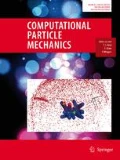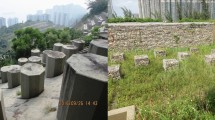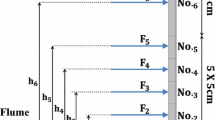Abstract
This study investigates the flow dynamics of a dry granular flow and force interaction with a rigid wall using the material point method (MPM). The model equations and solution scheme of the MPM are presented, and the inscribed Drucker–Prager model is adopted in the constitutive model of the MPM. An analytical solution to the classical dam-break problem is used to validate that the MPM can accurately simulate the large deformation problem. Then, the simulation of a channel flow experiment of a dry granular flow impacting a rigid wall is conducted. In the simulations, a bottom friction algorithm is presented based on the MPM. The simulation results of the normal force and bending moment of the rigid wall are consistent with the experimental results, which validated the correctness and effectiveness of the simulations. The internal velocity distribution of the granular flow at a critical time, the motion path of the key points, the influence of the bottom friction angle on the total normal force of the rigid wall, and the velocity and kinetic energy of the granular flow are analysed and discussed. Through the analysis of the granular flow position, the velocity vector of the internal point, and the force vector of the rigid wall at several key moments in the process of the granular flow impacting the rigid wall, the mechanism of the granular flow impacting a rigid wall is summarized. It can provide a scientific reference and basis for the prevention and control of the granular flow disaster and the design of a retaining wall.






























Similar content being viewed by others
References
Savage SB, Hutter K (1989) The motion of a finite mass of granular material down a rough incline. J Fluid Mech 199:177–215
Hutter K, Savage SB, Nohguchi Y (1989) Numerical, analytical, and laboratory experimental studies of granular avalanche flows. Ann Glaciol 13:109–116
Hungr O (1995) A model for the runout analysis of rapid flow slides, debris flows, and avalanches. Can Geotech J 32(4):610–623
Iverson RM, Denlinger RP (2001) Flow of variably fluidized granular masses across three-dimensional terrain: 1. Coulomb mixture theory. J Geophys Res Earth Surf 106(B1):537–552
Denlinger RP, Iverson RM (2001) Flow of variably fluidized granular masses across three-dimensional terrain: 2. Numerical predictions and experimental tests. J Geophys Res Earth Surf 106(B1):553–566
Greve R, Koch T, Hutter K (1994) Unconfined flow of granular avalanches along a partly curved surface. I. Theory. Proc R Soc Lond Math Phys Eng Sci. The Royal Society 445(1924):399–413
Gray J, Wieland M, Hutter K (1999) Gravity-driven free surface flow of granular avalanches over complex basal topography. Proc R Soc Lond Math Phys Eng Sci. The Royal Society 455(1985):1841–1874
Pitman EB, Nichita CC, Patra A, Bauer A, Sheridan M, Bursik M (2003) Computing granular avalanches and landslides. Phys Fluids 15(12):3638–3646
McDougall S, Hungr O (2004) A model for the analysis of rapid landslide motion across three-dimensional terrain. Can Geotech J 41(6):1084–1097
Iverson RM, Logan M, Denlinger RP (2004) Granular avalanches across irregular three-dimensional terrain: 2. Experimental tests. J Geophys Res Earth Surf 109(F1)
Hungr O, McDougall S (2009) Two numerical models for landslide dynamic analysis. Comput Geosci 35(5):978–992
Pitman EB, Nichita CC, Patra AK, Bauer AC, Bursik M, Webb A (2003) A model of granular flows over an erodible surface. Discrete Contin Dyn Syst Ser B 3(4):589–600
McDougall S, Hungr O (2005) Dynamic modelling of entrainment in rapid landslides. Can Geotech J 42(5):1437–1448
Iverson RM, Ouyang C (2015) Entrainment of bed material by Earth-surface mass flows: review and reformulation of depth-integrated theory. Rev Geophys 53(1):27–58
Chiou MC, Wang Y, Hutter K (2005) Influence of obstacles on rapid granular flows. Acta Mech 175(1–4):105–122
Faug T (2015) Depth-averaged analytic solutions for free-surface granular flows impacting rigid walls down inclines. Phys Rev E 92(6):062310
Calvetti F, Crosta G, Tatarella M (2000) Numerical simulation of dry granular flows: from the reproduction of small-scale experiments to the prediction of rock avalanches. Rivista Italiana di Geotecnica 2(2000):21–38
Montrasio L, Valentino R (2004) Experimental and numerical analysis of impact forces on structures due to a granular flow. WIT Trans Ecol Environ 77:267–276
Valentino R, Barla G, Montrasio L (2008) Experimental analysis and micromechanical modelling of dry granular flow and impacts in laboratory flume tests. Rock Mech Rock Eng 41(1):153
Teufelsbauer H, Wang Y, Chiou MC, Wu W (2009) Flow-obstacle interaction in rapid granular avalanches: DEM simulation and comparison with experiment. Granular Matter 11(4):209–220
Walther JH, Sbalzarini IF (2009) Large-scale parallel discrete element simulations of granular flow. Eng Comput 26(6):688–697
Teufelsbauer H, Wang Y, Pudasaini SP, Borja RI, Wu W (2011) DEM simulation of impact force exerted by granular flow on rigid structures. Acta Geotech 6(3):119–133
Zhou GGD, Sun QC (2013) Three-dimensional numerical study on flow regimes of dry granular flows by DEM. Powder Technol 239:115–127
Shirsath SS, Padding JT, Kuipers JAM, Reeters TWJ, Clercx HJH (2014) Numerical investigation of monodisperse granular flow through an inclined rotating chute. American Institute of Chemical Engineers 60(10):3424–3441
Zhang X, Wu Y, Zhai E, Ye P (2021) Coupling analysis of the heat-water dynamics and frozen depth in a seasonally frozen zone. J Hydrol 593:125603
Albaba A, Lambert S, Nicot F, Chareyre B (2015) Relation between microstructure and loading applied by a granular flow to a rigid wall using DEM modeling. Granular Matter 17(5):603–616
Wu F, Fan Y, Liang L, Wang C (2016) Numerical simulation of dry granular flow impacting a rigid wall using the discrete element method. PLoS ONE 11(8):e0160756
Shen W, Zhao T, Zhao J, Dai F, Zhou GGD (2018) Quantifying the impact of dry debris flow against a rigid barrier by DEM analyses. Eng Geol 241:86–96
Fan Y, Wu F (2019) Research on the obstruction process of rigid netting barriers toward granular flow. Adv Civ Eng 2019:1–18
Chung YC, Wu CW, Kuo CY, Hsiau SS (2019) A rapid granular chute avalanche impinging on a small fixed obstacle: DEM modeling, experimental validation and exploration of granular stress. Appl Math Model 74:540–568
Munjiza A, Latham JP, Andrews KRF (2000) Detonation gas model for combined finite-discrete element simulation of fracture and fragmentation. Int J Numer Methods Eng 49(12):1495–1520
Munjiza A, Latham JP, John NWM (2003) 3D dynamics of discrete element systems comprising irregular discrete elements—integration solution for finite rotations in 3D. Int J Numer Methods Eng 56(1):35–55
Munjiza A (2004) The combined finite-discrete element method. Wiley, New York
Munjiza A, Knight EE, Rougier E (2011) Computational mechanics of discontinua. Wiley, New York
Lei Z, Rougier E, Euser B, Munjiza A (2020) A smooth contact algorithm for the combined finite discrete element method. Comput Part Mech 7(5):807–821
Rougier E, Knight EE, Broome ST, Sussman AJ, Munjiza A (2014) Validation of a three-dimensional finite-discrete element method using experimental results of the split Hopkinson pressure bar test. Int J Numer Meth Eng 70:101–108
Rougier E, Knight EE, Lei Z, Munjiza A (2015) Recent development in the combined finite-discrete element method. In: Paper presented at the 1st Pan-American congress on computational mechanics—PANACM
Munjiza A, Rougier E, Knight EE (2014) Large strain finite element method: a practical course. Wiley, New York
Lei Z, Rougier E, Knight EE, Munjiza A, Viswanathan H (2016) A generalized anisotropic deformation formulation for geomaterials. Comput Part Mech 3(2):215–228
Knight EE, Rougier E, Lei Z, Euser B, Chau V, Boyce SH, Gao K, Okubo K, Froment M (2020) HOSS: an implementation of the combined finite-discrete element method. Comput Part Mech 7(5):765–787
Munjiza A, Rougier E, Zhou L, Knight EE (2020) FSIS: a novel fluid–solid interaction solver for fracturing and fragmenting solids. Comput Part Mech 7(5):789–805
Sulsky D, Schreyer HL (1996) Axisymmetric form of the material point method with applications to upsetting and Taylor impact problems. Comput Methods Appl Mech Eng 139(1–4):409–429
Bardenhagen SG, Brackbill JU, Sulsky D (2000) The material-point method for granular materials. Comput Methods Appl Mech Eng 187:529–541
Chen Z, Hu W, Shen L, Xin X, Brannon R (2002) An evaluation of the MPM for simulating dynamic failure with damage diffusion. Eng Fract Mech 69(17):1873–1890
Bardenhagen SG, Kober EM (2004) The generalized interpolation material point method. Cmes-Comput Model Eng Sci 5(6):477–496
Andersen S, Andersen LV (2010) Modelling of landslides with the material-point method. Comput Geosci 14(1):137–147
Mast CM, Arduino P, Miller GR, Mackenzie-Helnwein P (2014) Avalanche and landslide simulation using the material point method: flow dynamics and force interaction with structures. Comput Geosci 18(5):817–830
Shi B, Zhang Y, Zhang W (2019) Run-out of the 2015 Shenzhen landslide using the material point method with the softening model. Bull Eng Geol Env 78(2):1225–1236
Soga K, Alonso E, Yerro A, Kumar K, Bandara S (2016) Trends in large-deformation analysis of landslide mass movements with particular emphasis on the material point method. Geotechnique 66(3):248–273
Liu X, Wang Y, Li D (2019) Investigation of slope failure mode evolution during large deformation in spatially variable soils by random limit equilibrium and material point methods. Comput Geotech 111:301–312
Acosta JLG, Vardon PJ, Hicks MA (2021) Development of an implicit contact technique for the material point method. Comput Geotech 130:103859
Jiang Y, Towhata I (2013) Experimental study of dry granular flow and impact behavior against a rigid retaining wall. Rock Mech Rock Eng 46(4):713–729
Funding
The research reported in this manuscript is funded by the Project funded by National Natural Science Foundation of China (Grant No. 52008268). China Postdoctoral Science Foundation (Grant No. 2019M651211), Scientific Research Project of Liaoning Provincial Department of Education (Grant No. lnqn201905), and Nurture Fund for Research Innovation of Shenyang Jianzhu University (Grant No. CXPY2017016).
Author information
Authors and Affiliations
Corresponding author
Ethics declarations
Conflict of interest
The authors declare that they have no conflict of interest.
Additional information
Publisher's Note
Springer Nature remains neutral with regard to jurisdictional claims in published maps and institutional affiliations.
Rights and permissions
About this article
Cite this article
Wu, F., Chen, J., Fan, Y. et al. Simulation of the flow dynamics of a dry granular flow and force interaction with a rigid wall using the material point method. Comp. Part. Mech. 9, 673–692 (2022). https://doi.org/10.1007/s40571-021-00437-7
Received:
Revised:
Accepted:
Published:
Issue Date:
DOI: https://doi.org/10.1007/s40571-021-00437-7




